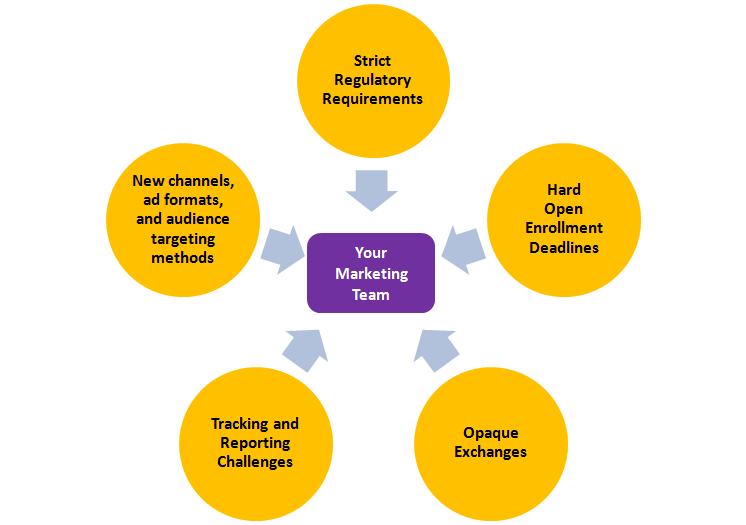
Many of my clients tend to start out an engagement by making various website changes, and often they are even already in the middle of, or about to embark on, a complete website redesign.
There are numerous articles and books about how to optimize website designs, but for SEO and Paid Search, there seem to always be some issues that perenially come up (the “usual suspects”) – all well worth highlighting.
Here is a standard, quick checklist I’ve developed for use with new and existing websites, to ensure the website is optimized for SEO and PPC purposes.
1. Content Management System Choice
The two leading CMSs are WordPress and Drupal. Joomla is a close third, but several people I know who have used it have told me that the first 90% of the job is very easy if you’re using Joomla, but the last 10% is a killer. If you’re a small or medium business, I see no reason why WordPress is not an ideal solution – after it’s designed, it’s easy for even a relatively inexperienced person to add pages, make changes, and so on.
B-to-B companies seem to be partial to Hubspot for lead management as well; my suggestion would be, rather than using Hubspot for your entire site, use WordPress and the Hubspot WordPress plug-in – that way most of your site is not “locked in” to Hubspot, so if it’s not working out for you, you still have a website.
If you’re agonizing over which CMS to select, just go to trends.google.com and search on [wordpress, drupal, joomla] and whatever else you’re considering – you’ll see that WordPress has them all beat by a wide margin.
2. Install SEO Plug-ins for your CMS
If you do choose WordPress, make sure you install either the “All-in-One SEO Pack” plug-in (poke around the WordPress Plug-Ins area and you will find it), or even better, you might try Yoast’s plugins for WordPress. These plug-ins make things like SEO-friendly URLs and writing Meta-Descriptions and the like easier, among other features. I use the “All-in-one SEO Pack” plugin myself on this blog, but@dan_shure over at EvolvingSEO has been raving about Yoast for WordPress, and Dan’s one of the sharpest guys I know so I’m confident it’s great.
Yoast also has a nice Google Analytics plug-in for WordPress you can install, to make integration with Google Analytics easy – you can download both plug-ins here:
Yoast Plug-Ins for WordPress
Dan Shure also wrote a great article where he covers how Yoast works (and some other great info on WordPress in general) here, it’s very much worth a read: Are You Setting Up WordPress for SEO Success?
3. E-Commerce System Choice
There are hundreds of E-Commerce/Shopping Cart systems out there; with many you can do your entire site. If you have a store section of your site, get one of these, but try to limit its use to only your “Store” section (if applicable), they usually are not that great for making entire websites. Instead, use WordPress for as much of the website as possible and only use the E-Commerce system where absolutely necessary.
I don’t have a particular favorite as far as these go; I would say do some research, and when you’ve identified a few you like, check them out in trends.google.com (as above), to see how often people search on their brand names. Selecting the one that is more popular is usually a safer move than selecting an obscure one.
4. Have A Place For Your Blog To Live
Make sure you have a section on the new site for a Blog (ideally, a menu item). If you don’t have a blog – you probably will down the road – leave plenty of room for a “Blog” menu item for use at a later date!
5. Have a Place, or Several Places, for “Evergreen” Content to Live
Have one or two menus that you can use to place new SEO content in as you come out with it- they could be named “Solutions”, “Technology”, “Our Services”, “Issues”, “White Papers”, “Application Notes”, etc. You will need to place “evergreen” (i.e. content that will live forever) somewhere – try to have two separate menus if at all possible. I am also partial to menus that let you drill down to two levels. This approach can accommodate numbers of content pages, but if you only plan on having 20-30 pages, two levels may be overkill.
Just make sure you have plenty of places to put content later as you expand your efforts.
6. Have Separate Privacy Policy and Terms of Service Pages
Make sure you have a page for each of these, and footer links on every page of the website to them. Why?
Well, if you ever do PPC down the road, trust me, you’ll want these; Google actually examines your website for them, as part of its assessment of “Landing Page Quality” and not having them can actually negatively impact your keyword “Quality Scores”. Quality Scores are used to adjust what you pay after each auction – so you can actually end up paying more for clicks, and may be shown less, if you don’t have these in place. I have seen this repeatedly with clients and can’t emphasize this enough – put them in place! Also, it’s just good business to set proper expectations with your users.
The next question I usually get is, do I have a “standard” Privacy Policy and Terms of Service I can recommend? Well, I’m no lawyer, so you’re completely on your own on this – but the Better Business Bureau has a privacy policy mix-and-match build-your-own page here worth checking out:
http://spokane.bbb.org/privacyhelp/
As far as Terms of Service, I’ve never been able to find a nice standardized one – my sense is most people just find a site with one they like (maybe in the same or a similar market) and craft something along those lines.
As long as you have “Terms of Service” in one page’s Title and “Privacy Policy” in the other title, and you have links to them from every page on your website….from a Quality Score standpoint that’s the main thing. It’s not thought that Google does much analyzing of the actual text of these pages – just focus on whatever makes the most sense from a business standpoint for you.
7. Have Your Phone Number In A Large Font At The Top Right
This may seem obvious, but you’d be surprised how often people miss this key item. Make your phone number noticeable – if you can get it somewhere on the right, near either the top, or have it be the first thing on the right below the menu bar, and of a larger font than the rest of the page, that will encourage callers (if these are important to you). Ideally have it on every page.
8. Have Two Separate “Contact Us” Pages, With Two Separate “Thank You” Pages
Ideally, you would have a primary “Contact Us” page, for Organic Traffic, and a second one (can be identical but with a different URL) for Paid Search traffic. If you do that (and put a “noindex” tag on the Paid Search one, and block it in your robots.txt file), this will make tracking much easier. The “noindex” tag can be added as follows (add it inside the “head” section of the page you want Google to leave out of its index, i.e. both the “Contact Page” for Paid Search and its Thank-You page:
<META NAME=”ROBOTS” CONTENT=”NOINDEX, NOFOLLOW”>
In both cases, having a separate “Thank You” page that comes up when someone submits their information, *with a separate URL*, will make tracking an absolute cinch – one need merely list the endings of the URLs in Google Analytics later and expose that data to Adwords. I like web developers to do Contact Pages this way because then they don’t have to add any special code anywhere for tracking, other than the Google Analytics code that will go on every page of the site.
So make sure you noindex the Paid Search “Contact Us” page and its corresponding “Thank You” page, and block them both in robots.txt.
9. Put Redirects in Place for WWW and Non-WWW Versions of the Site
Basically, before you get going with Google Webmaster Tools and Google Analytics, you should figure out, is your primary website URL going to be http://foo.com/ or is it http://www.foo.com/ – put 301 redirects in place to ensure the proper behavior, before you have to tell Google Webmaster Tools etc. which version of the site to track (that way there will only be one site, conceptually, rather than possibly two. I have one client who who ended up with separate GWT setups for the two different versions, which can make analysis difficult.
For more on this issue, see my article: The Highest ROI One-Line SEO Change You Will Ever Make
10. Add Google Analytics and Google Webmaster Tools Tracking
Google Analytics (GA) will be useful for tracking activity on the website, and if you set up its tracking, you can actually use that as your tracking for AdWords as well. This allows you to skip the additional hassle down the road of setting up Google Adwords tracking. Note – Google Analytics credits the *first* click that brought a visitor to your website – AdWords credits the *last* click – but unless you’re planning on being a huge AdWords spender, you probably don’t need to worry about the difference in their behavior.
In the case of Google Analytics (which is free), you’ll add a snippet of code to every page of your website (perhaps in a header for instance).
Sign up and go through the process to create the snippet here:
http://www.google.com/analytics/
Google also has a free tool called Google Webmaster Tools (GWT); this allows you to see if and how Google’s spider, (“googlebot”), is spidering your website, and whether it’s having any problems. GWT can use the Google Analytics tag to authenticate (i.e. connect) your account to the website, or alternately you can drop a Google Webmaster Tools code snippet on just the home page of the website, just for Google Webmaster Tools.
To sign up and get started, go here:
https://www.google.com/webmasters/tools/home?hl=en
11. Place a Customer Testimonial “Above The Fold”
This can simply be a square callout with a quote along the lines of “Company X did a great job for us – Joe Smith, Acme Co.” – and by “Above The Fold”, I mean, the region of your web page that is visible, without scrolling down, for most customers.
Don’t underestimate the value of prominently showing a customer testimonial (typically either on the far left, or the far right of the screen). At least do so on your home page, or more ideally, on every page.
If you’re late in the design process, a simple way to cheat at adding one is to take the (typically) large image on the home page and simply edit the image and drop the callout into the image itself, then load the new image. If at all possible, it’s far better to have one on every page though – ideally through the use of CSS style sheets etc.
12. Keep Directory Levels in URLs Shallow
The best URL for a document on “squeaky floors” is simply
http://www.foo.com/squeaky-floors
It’s best to resist the temptation to list a directory in there as well (such as /content/). If you have to have directories (say, to match up with your menus, that’s fine) just make sure they make sense, like
http://www.foo.com/whitepapers/debt-consolidation.html
13. Use Dashes, not Underscores in URLs
This is an SEO best practice that Google itself explicitly recommends, in its search optimization starter guide. So for instance, don’t use
http://www.foo.com/squeaky_floors
but, rather, use
http://www.foo.com/squeaky-floors
14. Make Sure Your Name/Address/Phone are Consistent
Many firms put these in a footer on every page, and also on their “Contact” or “About” pages. If you do put them in multiple places, make sure you have the same addresses and phone numbers in each case.
Don’t list your local phone number in one case and an 800 number in the other, or if you do, show both, with the local number showing first. This has the potential to impact you later in optimizing to rank for “local” searches (i.e. [keyword geographic area] combinations). For more on this, read my article:
SEO for Local Search: The Complete Guide
15. If It’s A Website Redesign, Prepare a Redirect File Prior To Launch
Redirects allow search engine spiders to credit existing links that are pointing at the old versions of pages, to the new URLs. You don’t want to lose all the PageRank value of all the links you’ve built up previously, so be sure to address this. Use “301″ (permanent) redirects, and point the most relevant pages to their counterparts when doing so. Avoid blanket redirects (like redirecting the entire old site, every page, to the new home page).
If you want to prioritize, you can use tools like Majestic-SEO or SEOMoz LinkScape to figure out what pages have links (at all), or which ones most links to them, and you can perhaps reduce the size of your redirect file significantly by just focusing on the high-runners. But my preference, if there are’ few enough pages, is to try to account for all of them.
16. Advanced Architecture Considerations
For the most part, if you’re doing a website in WordPress, your design is probably going to be fine – most companies seem to be migrating towards the standard menu-bar-at-the top, three blocks in the middle (or one large picture), and three blocks of content/links at the bottom (or one block) approaches. I see the three block design quite often now, and it does look quite sharp – people like thinking in threes, and this also breaks the page up in a pleasing way.
If you really want to make sure you’re organizing your website optimally for SEO purposes, you can read my article:
Website Architecture for SEO – The Complete Guide
…but if your site is for a Small or Medium Business – you probably don’t need to obsess over the level of detail explained there. Your web designer or web development firm might learn a few things from it though, it may make sense to have them check it out.
Conclusion
I would caution many of you out there, I often see clients who “hate their website” (and usually their previous web development firm or designer as well).
In many of these situations, what is needed is not a new website at all – often the website is quite functional – but it simply needs an updated look-and-feel, with better graphics, fonts, menus, and the like. This can often be accomplished simply through some updated designs, CSS template changes, and updated HTML.
It’s human nature to always wants to start fresh to avoid problems of the past (and “really get it right this time”), but if you already have a functioning website with decent customer traffic, analytics in place, and content to attract organic users – don’t throw the baby out with the bathwater – consider just a website “refresh” project, rather than a complete website replacement.
If you do a “refresh” though, run through the checklist above – you may be surprised how many items you have never paid attention to, that could put you in a better position to capitalize on SEO and PPC traffic.

Our CEOs Predictions for 2025 on SearchEngineLand
SearchEngineLand recently solicited 2025 predictions from various PPC experts; our CEO Ted Ives’ predictions are among them here (click on article below to read):


